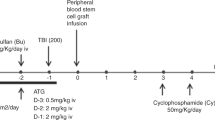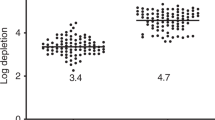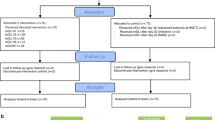Abstract
Graft-versus-host disease (GVHD) is a major cause of mortality and morbidity after allogeneic bone marrow transplantation, but can be avoided by removing T lymphocytes from the donor bone marrow. However, T cell depletion increases the risk of graft rejection. In this study, two strategies are used to overcome rejection: (1) use of high doses of stem cells obtained from peripheral blood (PBSC), (2) admixture with a CD52 monoclonal antibody in order to deplete both donor and residual recipient lymphocytes. Two antibodies are compared: CAMPATH-1G (rat IgG2b) and its humanized equivalent CAMPATH-1H (human IgG1). A total of 187 consecutive patients at six centers received PBSC transplants from HLA-matched siblings between 1997 and 1999. A wide spectrum of diseases, both malignant and non-malignant, was included. The recovery of CD34+ cells after antibody treatment was close to 100%. The risk of acute GVHD (grade 2 to 4) was 11% in the CAMPATH-1G group and 4% in the CAMPATH-1H group (P = NS). The risk of chronic GVHD (any grade) was 11% in the CAMPATH-1G group and 24% in the CAMPATH-1H group (P = 0.03) but the risk of extensive chronic GVHD was only 2%. The overall risk of graft failure/rejection was 2%, not significantly different between the two antibodies. Antibody treatment was equally effective at concentrations between 10 μg/ml and 120 μg/ml and it made no significant difference to the outcome whether the patients received post-transplant immunosuppression or not (87% did not). Transplant-related mortality in this heterogenous group of patients (including high-risk and advanced disease) was 22% at 12 months. It is proposed that treatment of peripheral blood stem cells with CAMPATH-1H is a simple and effective method for depleting T cells which may be applicable to both autologous and allogeneic transplants from related or unrelated donors. Special advantages of this approach are the simultaneous depletion of donor B cells (which reduces the risk of EBV-associated lymphoproliferative disease) and the concomitant infusion of CAMPATH-1H to deplete residual recipient T cells and thus prevent graft rejection. Bone Marrow Transplantation (2000) 26, 69–76.
This is a preview of subscription content, access via your institution
Access options
Subscribe to this journal
Receive 12 print issues and online access
$259.00 per year
only $21.58 per issue
Buy this article
- Purchase on Springer Link
- Instant access to full article PDF
Prices may be subject to local taxes which are calculated during checkout

Similar content being viewed by others
References
Hale G . Campath-1 antigen (CD52). In: Delves PJ, Roitt I (eds) Encyclopedia of Immunology Academic Press: London 1998 pp402–406
Hale G, Bright S, Chumbley G et al. Removal of T cells from bone marrow for transplantation: a monoclonal antilymphocyte antibody that fixes human complement Blood 1983 62: 873–882
Hale G, Waldmann H for CAMPATH users . Control of graft-versus-host disease and graft rejection by T cell depletion of donor and recipient with CAMPATH-1 antibodies. Results of matched sibling transplants for malignant diseases Bone Marrow Transplant 1994 13: 597–611
Hale G, Waldmann H for CAMPATH users . CAMPATH-1 monoclonal antibodies in bone marrow transplantation Hematother 1994 3: 15–31
Bunjes D, Heit W, Arnold R et al. Evidence for the involvement of host-derived OKT8-positive T cells in the rejection of T-depleted HLA-identical bone marrow grafts Transplantation 1987 43: 501–505
Kernan NA, Flomenberg N, Dupont B, O‘Reilly RJ . Graft rejection in recipients of T-cell depleted HLA-identical marrow transplants for leukemia. Identification of host-derived anti-donor allocytotoxic T lymphocytes Transplantation 1987 43: 842–847
Cobbold SP, Martin G . Waldmann H. Monoclonal antibodies for the prevention of graft-versus-host disease and marrow graft rejection: the depletion of T-cell subsets in vitro and in vivo Transplantation 1986 42: 239–247
Dyer MJS, Hale G, Hayhoe FGJ, Waldmann H . Effects of CAMPATH-1 antibodies in vivo in patients with lymphoid malignancies: influence of antibody isotype Blood 1989 73: 1431–1439
Hale G, Clark M, Waldmann H . Therapeutic potential of rat monoclonal antibodies: isotype specificity of antibody-dependant cell-mediated cytotoxicity with human lymphocytes J Immunol 1985 134: 3056–3061
Hale G, Zhang M-J, Bunjes D et al. Improving the outcome of bone marrow transplantation by using CD52 monoclonal antibodies to prevent graft-versus-host disease and graft rejection Blood 1998 92: 4581–4590
Jacobs P, Wood L, Fullard L et al. T-cell depletion by exposure to CAMPATH-1G in vitro prevents graft-versus-host disease Bone Marrow Transplant 1994 13: 763–769
Riechmann L, Clark M, Waldmann H, Winter G . Reshaping human antibodies for therapy Nature 1988 322: 323–327
Osterborg A, Fassas AS, Anagnostopoulos A et al. Humanized CD52 monoclonal antibody Campath-1H as first-line treatment in chronic lymphocytic leukemia Br J Haematol 1996 93: 151–153
Bowen AL, Zomas A, Emmett E et al. Subcutaneous CAMPATH-1H in fludarabine-resistant/relapsed chronic lymphocytic and B-prolymphocytic leukaemia Br J Haematol 1997 96: 617–619
Hale G, Cobbold SP, Waldmann H et al. Isolation of low-frequency class-switch variants from rat hybrid myelomas J Immunol Meth 1987 103: 59–67
Page MJ, Sydenham MA . High level expression of the humanized monoclonal antibody CAMPATH-1H in chinese hamster ovary cells Bio/Technology 1991 9: 64–68
Chatenoud L, Ferran C, Legendre C et al. In vivo cell activation following OKT3 adminstration. Systematic cytokine release and modulation by corticosteroids Transplantation 1990 49: 697–702
Sutherland DR, Anderson L, Keeney M et al. The ISHAGE guidelines for CD34+ cell determination by flow cytometry J Hematother 1996 5: 213–226
Bensinger WI, Buckner CD . Allogeneic peripheral blood stem cell transplantation. In: Atkinson K (ed.) Clinical Bone Marrow and Blood Stem Cell Transplantation Cambride University Press: Cambridge, UK 2000 pp582–599
Urbano-Ispizua A, Solano C, Brunet S et al. Allogeneic transplantation of selected CD34+ cells from peripheral blood: experience of 62 cases using immunoadsorption or immunomagnetic technique. Spanish Group of Allo-PBT Bone Marrow Transplant 1998 22: 519–525
Bindon CI, Hale G, Waldmann H . Importance of antigen specificity for complement-mediated lysis by monoclonal antibodies Eur J Immunol 1988 18: 1507–1514
Gilleece MH, Dexter TM . Effect of Campath-1H antibody on human hematopoietic progenitors in vitro Blood 1993 82: 807–812
Olweus J, Lund-Johansen F, Terstappen LWMM . Expression of cell surface markers during differentiation of CD34+, CD38−/lo fetal and adult bone marrow cells Immunomethods 1996 5: 179–186
Williams RJ, Clarke E, Blair A et al. Impact on T-cell depletion and CD34+ cell recovery using humanised CD52 monoclonal antibody (CAMPATH-1H) in bone marrow and PBSC collections: comparison with CAMPATH-1M and CAMPATH-1G Cytotherapy (in press)
Slaper-Cortenbach IC, Wijngaarden du Bois MJ, de Vries van Rossen A et al. The depletion of T cells from hematopoietic stem cell transplants Rheumatol 1999 38: 751–754
Apperley JF, Mauro FR, Goldman JM et al. Bone marrow transplantation for chronic myeloid leukemia in first chronic phase: importance of a graft-versus-leukemia effect Br J Haematol 1988 9: 239–245
Novitzky N, Thomas V, Hale G, Waldmann, H . Ex vivo depletion of T cells from bone marrow grafts with CAMPATH-1 in acute leukemia Transplantation 1999 67: 620–626
Davison GM, Novitzky N, Kline A et al. Immune reconstitution following allogeneic bone marrow transplantation depleted of T-cells Transplantation 2000 69: 1341–1347
Hale G, Waldmann H for CAMPATH users . Risks of developing EBV-related lymphoproliferative disorders following T cell depleted marrow transplants Blood 1998 91: 3079–3083
Oakhill A, Pamphilon DH, Potter MN et al. Unrelated donor bone marrow transplantation for children with relapsed acute lymphoblastic leukamia in second complete remission Br J Haematol 1996 94: 574–578
Koh MBC, Prentice HG, Lowdell MW . Selective removal of alloreactive cells from haematopoietic stem cell grafts: graft engineering for GVHD prophylaxis Bone Marrow Transplant 1999 23: 1071–1079
Acknowledgements
Antibody production for these studies was supported by the UK Medical Research Council, LeukoSite Inc, and EP Abraham‘s Trust. We are indebted to many colleagues who played an important part in the production of antibodies, care of patients, data collection and analysis, including the staff of the Therapeutic Antibody Centre, University of Oxford, also Bernard Chapuis, Claudine Helg, Corinne Charrin, Colette Grand, and Kate Schoonooghe.
Author information
Authors and Affiliations
Rights and permissions
About this article
Cite this article
Hale, G., Jacobs, P., Wood, L. et al. CD52 antibodies for prevention of graft-versus-host disease and graft rejection following transplantation of allogeneic peripheral blood stem cells. Bone Marrow Transplant 26, 69–76 (2000). https://doi.org/10.1038/sj.bmt.1702477
Received:
Accepted:
Published:
Issue Date:
DOI: https://doi.org/10.1038/sj.bmt.1702477
Keywords
This article is cited by
-
Ab locks for improving the selectivity and safety of antibody drugs
Journal of Biomedical Science (2020)
-
Mesenchymal stem cells: a promising way in therapies of graft-versus-host disease
Cancer Cell International (2020)
-
Allogeneic hematopoietic stem cell transplantation using unrelated cord blood or unmanipulated haploidentical donors is effective in pediatric chronic granulomatous disease with inflammatory complications and severe infection
Bone Marrow Transplantation (2020)
-
Clinical evaluation of haploidentical hematopoietic combined with human umbilical cord-derived mesenchymal stem cells in severe aplastic anemia
European Journal of Medical Research (2018)
-
The immunological function of CD52 and its targeting in organ transplantation
Inflammation Research (2017)



